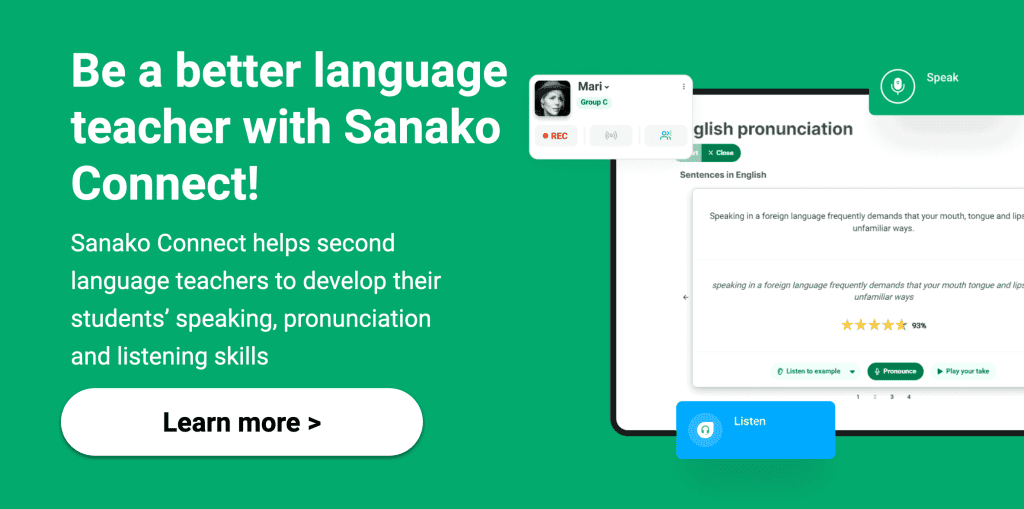In a world increasingly interconnected and diverse, the ability to effectively mediate communication between individuals from different cultural and linguistic backgrounds is a crucial skill. Such is its importance that the Common European Framework of Reference for Languages (CEFR) recognizes mediation as one of the four modes of language activity, alongside reception, interaction and production. In this post, we will explore what mediation skills is, why it’s a crucial skill for language learners, and how language educators can help their students develop this invaluable skill.
By teaching language learners to be effective mediators, educators are helping to equip them with the tools they need to communicate effectively and boost their language proficiency. Students can also develop key future skills such as problem-solving, critical thinking plus social and emotional understanding. These are essential for success in today’s business environment.
What are mediation skills?
Mediation, in the context of language learning, is the ability to facilitate communication between two parties who do not share a common language. It involves interpreting and translating information, ideas, and messages accurately while taking cultural nuances into account.
Importantly mediation skills focus on the practical use of core language skills (reading, writing, listening and speaking) in real-life contexts and situations. Their use is about bridging linguistic gaps, making them an essential asset for all language learners.
Mediation, as defined by the CEFR, involves “acting as a social agent who creates bridges and helps to construct or convey meaning.” This entails understanding and conveying information in a clear, concise, and culturally sensitive manner, ensuring that all parties involved feel heard and respected.
The CEFR goes further, providing a comprehensive framework for developing and assessing mediation skills at all levels of language proficiency. Their descriptors for mediation skills are organised into three scales:
- Mediating texts: This scale focuses on the ability to relay specific information, summarise texts and adapt information for different audiences.
- Mediating concepts: This scale focuses on the ability to explain concepts, mediate group discussions and present information effectively.
- Mediating communication: This scale focuses on the ability to act as an intermediary in informal situations, resolve conflicts, and facilitate communication between individuals with different language backgrounds.
Why are mediation skills so important in language learning?
Having identified what mediation skills are, it’s important to examine why such skills are so important for language learners. A review of research in the area identifies three key reasons.
- Real-world relevance: Mediation is not just a theoretical concept. Language learners often find themselves in situations where they need to mediate. Whether it’s translating for tourists, helping colleagues understand complex documents or facilitating international business negotiations, mediation skills are highly relevant and exceptionally transferable.
- Boosting language proficiency: Developing mediation skills enhances language proficiency as students engage deeply with the context, structure and of their chosen language. This serves to make language learning more immersive and enjoyable.
- Cultural competence: Mediation isn’t just about words; it’s also about understanding cultural nuances. It helps learners understand how to navigate the subtleties of communication, which is crucial for avoiding misunderstandings and promoting effective communication and interaction.
How to develop mediation skills in your language classroom
Although this sounds like a complicated, new set of skills for you to teach, the concept of mediation skills is actually pretty similar to much of what already happens in good language teaching.
As Tim Goodier suggests in a paper published by OUP on the subject, a good starting point would be to: “Think about how you already use mediation in your classes, and how you could extend this. How could you select and adapt mediation descriptors to improve your students’ learning outcomes?”
He continues: “Consider how goal-oriented tasks and mini projects can encourage them to process information, explain things to others in their own words, and build new ideas together.”
A couple of additional points to consider before getting underway.
- Don’t start to look at mediation skills until your students have strong core language skills. They will need a good level of proficiency in grammar, vocabulary, and pronunciation to underpin effective mediation.
- As with other teaching approaches, think carefully about personalising your students’ learning. Not all students will naturally mediate even in their L1, so may need more help to do so in their L2. More able learners may be able to peer peer support, which as Goodier details “is a key aspect of mediation itself.”
Using the CEFR framework outlined above, here’s four different ways to teach mediation skills in your language classroom.
1. Role-playing activities
Activity: Simulate real-world situations where students might have to mediate. For example:
- A tourist who speaks limited English asks a local city guide for directions to a popular tourist attraction.
- A customer service representative helps a customer who is having trouble with their internet service.
- A parent mediates a disagreement between their two children.
Step-by-step instructions:
- Divide your students into pairs or small groups.
- Assign each pair or group a different role-playing scenario.
- Ask students to prepare for their role-playing activity by brainstorming a list of key phrases and vocabulary that they might need.
- Have them perform their role-playing activities for the class.
- After each role-playing activity, ask students to reflect on what went well and what they could improve.
2. Simplify complex texts
Activity: Break down complex texts into simpler sentences or illustrate the main points. For example:
- Students could simplify a news article by identifying the main points and writing them in their own words.
- Students could create a visual representation of a complex scientific concept, such as a diagram or infographic.
Step-by-step instructions:
- Provide students with a complex text to read, such as a news article or scientific paper.
- Ask them to identify the main points of the text.
- Have students simplify the text by writing the main points in their own words or by creating a visual representation of the text.
- Students can then share their simplified texts with the class.
3. Group discussions
Activity: Mediate a group discussion by relaying the main points of the discussion to a student who missed it. For example:
- Choose one student to leave the class for 5 minutes.
- Discuss a certain topic with the rest of the class for those 5 minutes.
- Have the student re-enter the class and have the others relay the main points of the discussion to the one who missed it.
Step-by-step instructions:
- Choose a topic for the group discussion.
- Divide students into small groups.
- Have students discuss the topic for a set amount of time.
- After the discussion, have one student from each group leave the class.
- Discuss the topic with the remaining students in the class.
- Have the students who left the class re-enter and have the other students relay the main points of the discussion to them.
- Check for understanding by asking the students who missed the discussion to summarise the main points in their own words.
4. Cultural exchange
Activity: Explain a particular tradition or festival from your country to a partner and then relay the information to a new partner. For example:
- A student from Japan could explain the Japanese Obon festival to their partner.
- A student from Mexico could explain the Mexican Dia de Muertos holiday to their partner.
Step-by-step instructions:
- Have students pair up with a partner from a different cultural background.
- Ask students to choose a tradition or festival from their own country to explain to their partner.
- Give students time to prepare their explanation.
- Have students take turns explaining their chosen tradition or festival to their partner.
- After each explanation, ask students to rephrase what their partner has told them to ensure that they understand.
- Have students move into new pairs and relay the information they have learned to their new partner.
Using the above activities is a great way to foster students’ mediation skills. Doing so goes beyond language instruction: it empowers learners to become more effective communicators and to build key skills for today’s globalised world. By incorporating these engaging and practical activities into lessons, educators can help learners tackle real-world challenges and skillfully navigate different and difficult communication situations.
Sanako is the global-leader in teacher-led language instruction technology. Our software supports language teachers to deliver inspiring and effective lessons. If you’d like to find out more about how Sanako’s dedicated language teaching software could transform your approach to language teaching, click here or the banner below to learn more!

